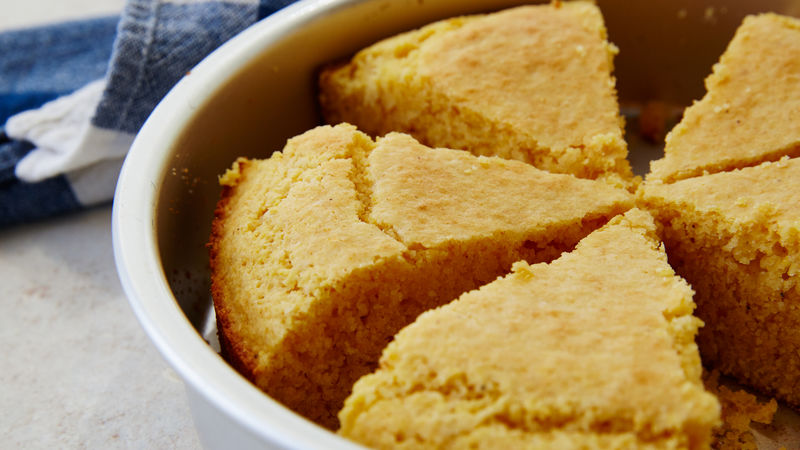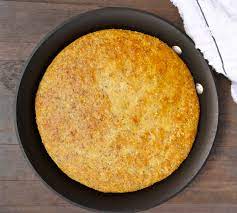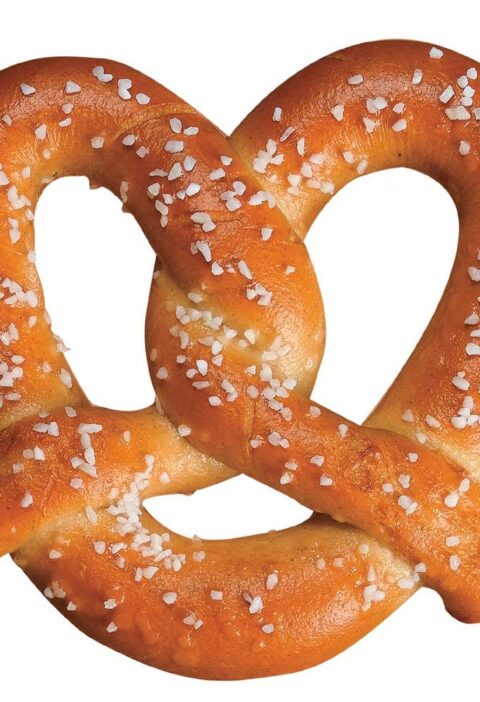This is the original recipe for the cornbread and the science behind its ingredients! (Refer to the link for measurements).
Structurally and in regards to texture, the flour, cornmeal and sugar are important to this recipe. The all purpose flour will provide the protein necessary for gluten formation, while also containing starch molecules that will aid in the overall structure building of the cornbread. Cornmeal provides a unique set of properties; it does not have any gluten and therefore does not aid in the structure building. It does provides flavor and offsets the liquids in this recipe to help make a tender bread texture. However, if too much is used it can result in a dense texture. Cornmeal is much more gritty than corn flour due to the degree of milling which can also cause a slightly stronger corn taste than corn flour would. Sugar also functions as a tenderizer and therefore prevents the gluten formation from becoming too tough. It provides flavor and sweetness in the bread and will influence protein coagulation (Larsen, 1).
Similarly, salt’s main purpose is to provide flavor. However, it also contributes in making the gluten structure strong for the foundation of the bread. Baking powder functions as the leavening agent, hydrating the proteins and starches, and producing air pockets in the cornbread. This is because as the batter bakes, the carbon dioxide produced by the baking powder makes air bubbles in the batter. These are then trapped by the surrounding structure of the batter which is mainly supported by the proteins in the flour and the egg. Melted butter also assists in the overall leavening of the cornbread because it is composed of about 20% water. Therefore, when it is put in the oven to bake the water will be converted into steam, which combined with the baking powder will create air pockets and provide leavening. Creating a well to incorporate the wet ingredients into the dry ingredients allows for the air pockets resulting from the interaction of the baking powder and melted butter to remain (Helmenstine, 1). The melted butter will also add liquid to the recipe to offset the solids. It functions as a tenderizer because its fat prevents gluten formation. This will prevent the cornbread from becoming too tough, allowing instead for a moist bread. The egg, in its entirety, will function as a binding agent and emulsifier because the yolk contains many proteins and fats. It also provides the cornbread with some water which will help with the overall texture and will help keep the bread moist (Larsen, 1).
The original recipe has milk (specifically whole milk), which is a mixture that contains mainly water with carbohydrates, fat, lactose, protein, vitamins, and minerals. In this recipe the lactose and protein from the milk causes browning, although less browning than soy milk. The baking powder will react to the milk because it is a liquid and as whole milk is acidic, the acidity reacts to the leavening agent (“Milk”, 1) .
To view the altered recipe click here.

The pan used for this recipe is a 9 inch round cake pan. Heat moves towards the inside of the pan, which is the longest part of cooking. The size of the cake pan will increase the cooking time as it will take longer for the heat to reach the center of the pan. If the metal pan is shiny it will have less heat retention because it will reflect the heat. If the pan is dull this will not be an issue and the bread will cook comparatively faster.
Cornbread recipe:
Melissa. Easy cornbread recipe – moist and fluffy homemade cornbread! https://www.blessthismessplease.com/the-best-cornbread-recipe/ (accessed Apr 12, 2023).
Feature picture reprinted from: Betty Crocker https://www.bettycrocker.com/recipes/cornbread/8990e15c-fc1d-4a8d-b8b3-4b37f45eca49
Picture reprinted from: Food Service Direct https://www.foodservicedirect.com/horizon-organic-whole-milk-1-gallon-4-per-case-22988755.html
Works Cited
Helmenstine, A. M. Here’s how baking powder makes things rise. https://www.thoughtco.com/how-baking-powder-works-607382#:~:text=Using%20Baking%20Powder%20Correctly,another%20water%2Dbased%20liquid%20ingredient. (accessed Apr 13, 2023).
Larsen, L. Cooking May Be an Art, but Baking Is a Science. The Spruce Eats. https://www.thespruceeats.com/baking-ingredient-science-481226.
Milk: Dairy: Baking ingredients. https://bakerpedia.com/ingredients/milk/ (accessed Apr 12, 2023).


